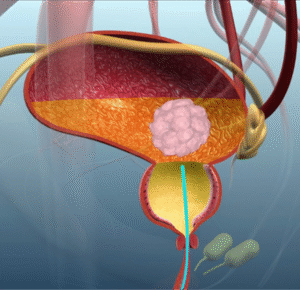Simple Prostatectomy – Robotic Assisted Enucleation
Robotic assisted enucleation of the prostate adenoma.
- For those large benign prostates where a TURP would be too time consuming, and too dangerous.
- Generally, prostates over 150cc.

Why is it done?
- This procedure is performed when the prostate gland is enlarged to such an extent that medication cannot relieve the urinary symptoms.
- Your prostate is larger than 120 cc
- Symptoms include: LUTS
- a weak stream,
- nightly urination,
- frequent urination,
- inability to urinate,
- kidney failure due to the weak urination (obstruction),
- bladder stones,
- recurrent bladder infections.
- Medication such as Flomaxtra, Xatral Minipress etc. should always be given as a first resort.
- Step-up therapy should have been used for prostates larger than 35-50cc with either Duodart, Avodart or Proscar and can be used as a first line in these huge prostates.
- Conservative management with medication has failed
- Doing transurethral resection may take excessively long causing side-effects to your urethra as well as risk of irrigation fluid being reabsorbed in your vascular system leading to increased cardiac load
- You may be at risk for electrolyte disturbances with a transurethral resection of the prostate when Glycine is used
- You have BPH—benign prostate enlargement
- Prostate cancer has been ruled out by doing a PSA, and when indicated, with a 3T MRI scan of the prostate with an abnormal PSA with a possible prostate biopsy of any suspicious lesions.
- A staged-TURP can also be performed to dis-obstruct a huge prostate. Either Bipolar resection or Laser can be utilized.
- Patient informed decision is vital.
- It provides a quicker solution with more marked side-effects and risks.
How is it done?
- Patients will receive a general anesthesia, unless contra-indicated.
- Prophylactic anti-biotics is given.
- A Flexible cystoscopy is done to exclude any urethral strictures, bladder cancers and any other pathology
- An IDC is then placed
- A Camera port is placed above the Umbilicus
- 3 Additional ports for robotic arms in a horizontal line on the abdomen with 2 assistant ports on the right side of the abdomen
- The abdominal space is entered and the bladder dropped from the abdominal wall.
- Bladder opened at the dome as the prostate will be removed through the bladder
- Bladder neck opened
- Prostate adenoma enucleated
- Haemostasis
- Trigonalization of bladder, bladder pulled down into prostate cavity
- Catheter replaced
- Drain placed if required
What next?
- You will spend up to 5-7 nights in hospital.
- You will have a catheter for that time.
- A drain for 2-3 days.
- You will a trial without the catheter on the 5th day.
- You will be discharged as soon as you can completely empty your bladder.
- You may initially suffer from urge incontinence and dysuria (irritable voiding) and will improve within the next 6 weeks.
- Allow for 6 weeks for stabilization of symptoms.
- There may be some blood in your urine. You can remedy this by drinking plenty of fluids until it clears.
- A ward prescription will be issued on your discharge, for your own collection at any pharmacy.
- A follow-up appointment will be scheduled for 6 weeks. Remember there is no pathology due to vaporisation.
- Don’t hesitate to ask Jo if you have any queries.
- DON’T SUFFER IN SILENCE, OR YOU WILL SUFFER ALONE!
Side-effects
- Blood loss requiring blood transfusion.
- Infection.
- Prolonged hospital stays.
- Retrograde ejaculation in more than 90% of patients. Therefore, if you have not completed your family, this procedure is not for you unless absolutely necessary.
- Infertility as a result of the retrograde ejaculation.
- Stress incontinence especially in the elderly and the diabetic patients.
- Patients with Multiple Sclerosis, Strokes and Parkinsons have a higher risk of incontinence and risks should be discussed and accepted prior to surgery.
- Less chance of growth of prostate lobes usually within 3-5 years requiring a second procedure.
- NB! Each person is unique and for this reason symptoms vary!
Remember
You still have a peripheral zone of your prostate and regular PSA reviews are required up to the age of 75.
Download Information Sheet
Wes RA-Enucleation Prostatectomy BPH

Leave a Reply
Want to join the discussion?Feel free to contribute!